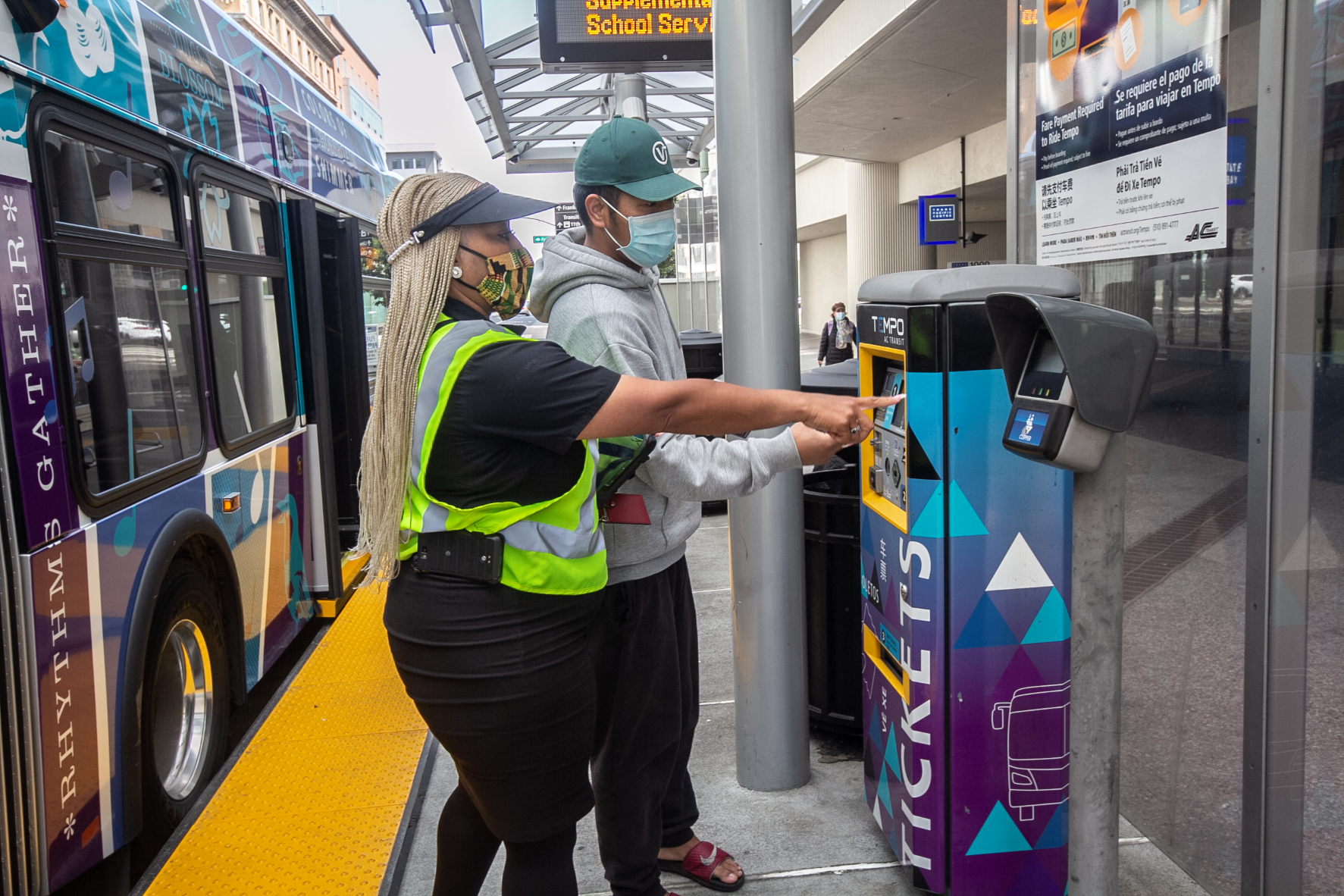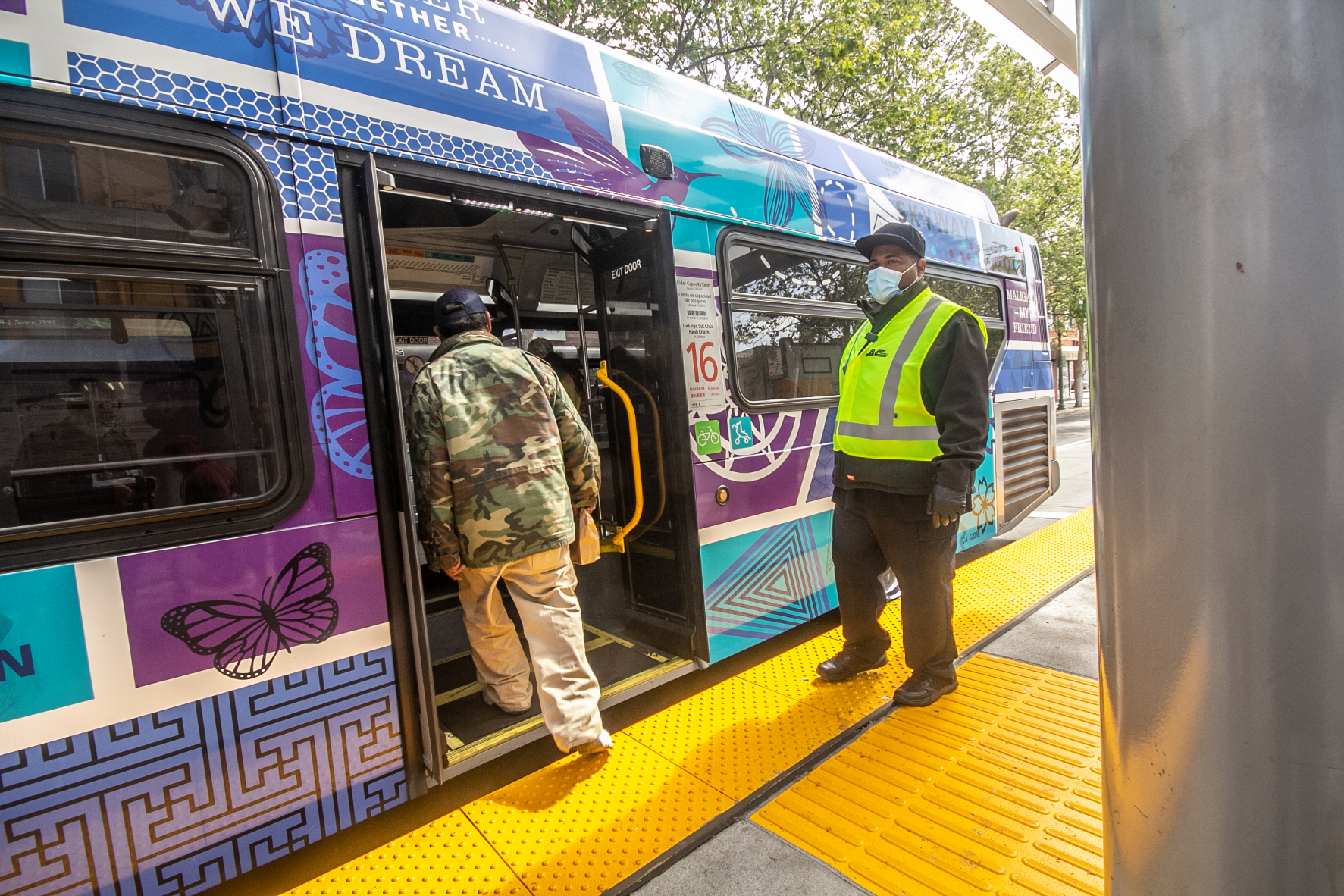
Several Bay Area transit agencies are improving bus reliability and cutting travel time with speedy bus routes in dedicated lanes — an offering that could expand as operators assess commute needs post-pandemic.
Today, bus-speed improvements are on Van Ness Avenue in San Francisco, International Boulevard between downtown Oakland and San Leandro, and on a few of Santa Clara County’s busiest corridors like El Camino Real. New projects are under exploration in Solano County and several East Bay locations.
These routes incorporate Bus Rapid Transit (BRT) features, lines that combine the hustle of light rail with the flexibility and cost-efficiency of a traditional bus. BRT can help meet the demand for efficient travel, climate-friendly modes of transportation and reduce traffic. Data show population growth will require the region’s transportation system to carry millions more passengers by 2050 on trains, ferries, buses, and roads, even as some people continue to telecommute.
For these reasons, the Metropolitan Transportation Commission (MTC) included BRT investment in Plan Bay Area (PBA) 2050. BRT is among several transportation strategies recommended to build a “next-generation transit network” to improve local transit frequency, capacity, and reliability.
Separately, in June, MTC reported it contributed $77 million (a combination of Regional Measure 2 funds and earlier investments) toward the Alameda-Contra Costa Transit District’s (AC Transit) Tempo BRT line, said John Goodwin, public information officer.
Even with policy support, rapid bus networks can take decades to plan, approve, and build due to a mix of land use, infrastructure, community engagement, funding and environmental review considerations — the latter of which could ease.
BRT is “still a work in progress because our agencies are struggling to deliver the type of dedicated lanes and top-quality stations quickly and affordably, which is essential to make this a realistic option for a lot of regional corridors,” said Jonathon Kass, transportation policy manager at SPUR, a nonprofit public policy group that asked “What Will It Take to Deliver Bus Rapid Transit in the Bay Area?” in a 2019 report.
Five “essential” features distinguish BRT from transitional bus service, as described by the Institute for Transportation & Development Policy (ITDP). These include bus-only lanes, “busway alignment” via the roadway’s center, off-board fare collection, intersection design prohibiting traffic turns across the bus lane, and platform-level boarding.
However, some transit agencies in the Bay Area and parts of the U.S. have adopted a pared-down definition Some even opt for “quick-to-deliver” design approaches. For example, queue jump lanes that give buses priority to enter the traffic flow, or bus bulbs, which are curb extensions that allow buses to board passengers without ever leaving the travel lane.

AC Transit staff assists rider with the pay-before-boarding system on the Tempo line.
Rapid Routes
The Santa Clara Valley Transportation Authority (VTA) was among the first Bay Area public transit agencies to plan for BRT. In 2009, its board of directors approved a strategic plan with routes on several high-trafficked corridors across six cities in Santa Clara County. But the concern from city officials about lane elimination and the loss of on-street parking — among other challenges — contributed to VTA’s decision to scrap BRT plans in 2018.
VTA instead focused on four “rapid” routes, which are faster, more frequent, and make one-to-two stops per mile, compared to four-to-five on traditional bus service lines. Route 522 is distinct among the four rapid lines because it has a dedicated bus lane along a 1.3-mile segment through East San Jose, and is one of VTA’s most popular rapid routes, said Jay Tyree, service planning manager.
In 2020, the Alameda-Contra Costa Transit District (AC Transit) launched Tempo BRT, serving transit-dependent, frontline workers living along the 9.5-mile route between Oakland and San Leandro. Tempo has bus-only lanes to increase travel speed and traffic signal technology to move through green lights faster. Riders pay before boarding the bus, also quickening the process.
Despite the challenges of introducing Tempo during a global pandemic, ridership and on-time performance are “record-setting” for AC Transit, said Robert Lyles, media affairs manager, adding the line captures 13 percent of the operator’s overall ridership.
San Francisco’s Van Ness BRT opened on April 1 of this year after significant delays and greater-than-expected costs for utility work. It travels on a two-mile stretch between Lombard and Mission streets. So far, it’s experiencing a 17 percent ridership increase and travel time savings of up to 35 percent northbound and 22 percent southbound, according to the San Francisco Municipal Transportation Agency (SFMTA). Buses run on dedicated, center-running transit lanes that have been painted red and receive traffic signal priority.
SFMTA introduced similar bus speed improvements on Geary Boulevard, the first phase of which was completed a year ago between Market and Stanyan streets. The second phase between Stanyan and 34th Avenue is underway. One difference is that SFMTA opted for side-running transit lanes along Geary because they only require capital construction for transit and safety improvements at spot locations, said SFMTA Spokesperson Erica Kato said.
In comparison, Kato added the Van Ness project “changed the entire roadway configuration to make room for new center-running bus lanes and boarding areas, requiring extensive demolition and reconstruction of medians and staging of equipment and materials along the entire corridor.”

Passenger boards the Tempo line at Fruitvale Station.
Reduced Car Reliance
Despite challenges, there is hope BRT lines will help reduce car reliance, especially in suburban areas where transit ridership is rebounding gradually. For example, the Solano Transportation Authority is looking into transitioning the Solano Express Bus service to a “BRT Lite” system as part of the Solano Connected Mobility Implementation Plan. It’ll share draft recommendations from the plan in the first quarter of 2023.
“We’re being proactive and want to plan our future, and hopefully, it’s competitive with the automobile,” said Daryl Halls, executive director of the Solano Transportation Authority.
Other agencies like VTA are working with cities to develop smaller, dedicated transit lane projects. That includes a pilot project with the City of San Jose for a side-running bus lane through a segment of Curtner Avenue, as well as consideration of side-running bus lanes along the Monterey Road corridor.
New projects could also surface in East Bay corridors. AC Transit is exploring potential with the Alameda County Transportation Commission to extend Tempo to the Bay Fair BART Station from the San Leandro Transit Center. Another proposal with the West Contra Costa Transportation Advisory Committee calls for a line along San Pablo Avenue. It’s too early to suggest which bus lines could be utilized by proposed projects, Lyles said.
“We remind our riders that AC Transit is a special district operating within 13 cities and jurisdictions,” Lyles said. “Each municipality maintains the right of way for all new corridors needed for BRT construction.”
Streamlining environmental review processes could help get projects off the ground faster and contribute to more robust BRT development. Senate Bill 922, authored by Scott Weiner (D-San Francisco) extends previous legislation exempting bike, pedestrian, light rail, and rapid bus projects from the California Environmental Quality Act (CEQA). The bill passed the legislature and is on Governor Gavin Newsom’s desk for signature as of August 23. Overall, launching a BRT system comprised of ITDP’s five essential features can be tricky to implement, especially when projects require heavy construction and subsequent partnerships between transit agencies and cities for repaving, utility replacement, and other needs.
Yet when rapid bus systems deliver travel-time savings of more than 30 percent, they’re demonstrating a value proposition for cities and transit agencies to promote to car-reliant people, as well as transit-dependent riders seeking options for faster, more efficient travel.
Top photo: AC Transit’s new Tempo BRT. All photos courtesy AC Transit.

